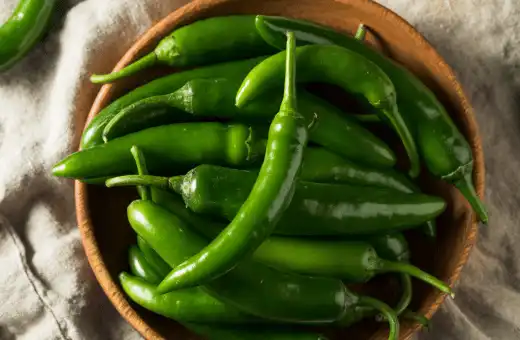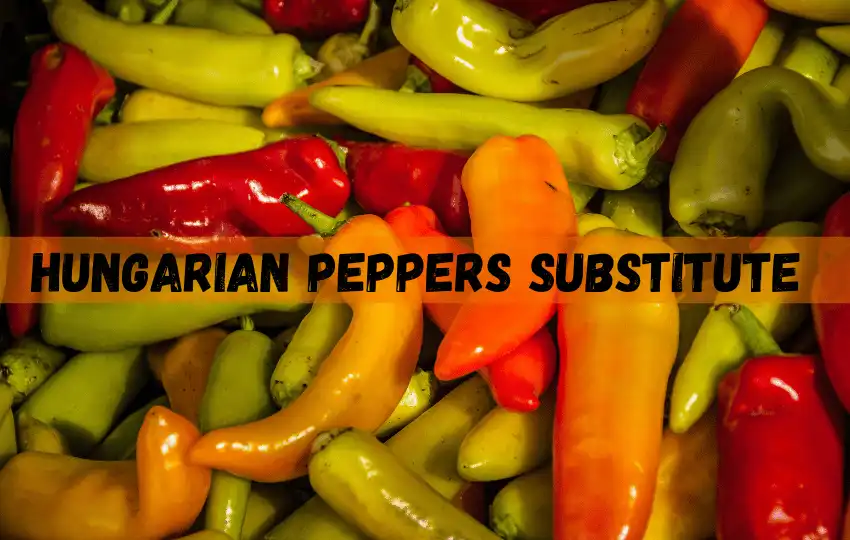Peppers are a crucial ingredient in many Hungarian dishes, from stews to soups, and they are often the star of the show in paprikash dishes.
But what if you run out of Hungarian peppers and need a quick substitution?
As an experienced home cook or chef, you know how crucial this is to find the perfect ingredient for each recipe.
That is why I collected a list of 16 ideal Hungarian peppers substitutes that you can use to create flavorsome, easy, and quick dishes for any mealtime.
Along with the substitutes, I’ll also share measurements so you can substitute Hungarian peppers with ease.
In short, " What can I use instead of Hungarian peppers?" Spanish Piquillo Peppers, Red Bell Peppers, Guajillo Peppers, Aleppo Peppers, Cayenne Peppers, Jalapeño Peppers, Anaheim Peppers, Paprika, Chili Powder, Poblano Peppers, Serrano Peppers, Bell Peppers and many more.
What are Hungarian peppers, and what do Hungarian peppers taste like?
Hungarian peppers, also known as Hungarian wax peppers, are a type of chili pepper that comes from Hungary.
They are medium-sized peppers, typically measuring about 4-6 inches in length, and they come in various shades of yellow or green with a waxy texture.
In terms of taste, Hungarian peppers are known for their mild to moderate heat level. They are generally less spicy than jalapeños or serrano peppers but can still have a noticeable kick.
The flavor of Hungarian peppers is often described as slightly sweet with a hint of fruitiness, making them a popular choice for culinary applications.
Uses of Hungarian peppers
Hungarian peppers are versatile and can be used in a variety of ways in cooking. Here are some common uses of Hungarian peppers:
1. Stuffed peppers: Hungarian peppers are often used for stuffing with a mixture of rice, meat, cheese, or vegetables. They can be baked or grilled after being stuffed to create a delicious and flavorful dish.
2. Pickling: Hungarian peppers are great for pickling due to their mild heat and firm texture. They can be pickled whole or sliced and added to pickling brine to create tangy and spicy pickled peppers.
These pickled peppers can be used as a condiment or added to sandwiches, salads, or antipasto platters.
3. Sautéing and stir-frying: Hungarian peppers can be sliced or chopped and sautéed or stir-fried with other vegetables, meats, or seafood. They add a mild level of heat and a pop of color to stir-fries, fajitas, or vegetable medleys.
4. Roasting and grilling: Roasting or grilling Hungarian peppers enhances their natural sweetness and adds a smoky flavor.
They can be roasted or grilled until the skin is charred, then peeled and used in various dishes like soups, stews, and salsas or as a topping for pizzas and sandwiches.
5. Salsas and sauces: Hungarian peppers can be used to make flavorful salsas and sauces.
They can be blended with other ingredients like garlic, onions, tomatoes and spices to create a zesty salsa or sauce to accompany Mexican or Mediterranean dishes.
6. Drying and grinding: Hungarian peppers can be dried and crushed into a powder to create a spicy seasoning.
This pepper powder can be used to add heat and flavor to various dishes, such as chili, marinades, or spice rubs.
Where to buy Hungarian peppers?
If you searching for where to buy Hungarian peppers, there are a few different places you can go. Many specialty food stores carry it, as do some international grocery stores.
You can also order online from many retailers that provide a variety of diverse flavors and types of Hungarian peppers.
Best Hungarian peppers substitutes
1. Spanish Piquillo Peppers

These peppers have a sweet, fruity flavor with a gentle heat level and are perfect for adding color and flavor to stews and soups.
Just be sure to drain them before incorporating them into your recipe, and adjust the salt as needed.
You can find them in jars at most grocery stores and online.
2. Red Bell Peppers
Suppose you are looking for a mild and sweet pepper with a similar flavor to Hungarian peppers. In that case, red bell peppers are your perfect substitute.
These’re available at most grocery stores and have a mild heat level that won’t overpower your dish.
3. Guajillo Peppers
If you are looking for a little spicy substitute for Hungarian peppers, then guajillo peppers are a great option.
These Mexican peppers have a mild heat level but a smoky, earthy flavor that pairs well with meat dishes.
For every Hungarian pepper, consider using 2-3 Guajillo peppers.
You can find them dried in the Latin section of most grocery stores.
4. Aleppo Peppers

These Syrian peppers have a fruity, slightly sweet aroma with a moderate heat level, making them an excellent substitute for Hungarian peppers in dishes like goulash and paprikash dishes.
You can find these online and in the Middle Eastern section of some grocery stores.
5. Cayenne Peppers
If you are looking for a fiery substitute for Hungarian peppers, cayenne peppers are your best bet.
These small peppers pack a punch with a heat level ranging from 30,000 to 50,000 Scoville units, so use them sparingly.
You can find them dried or fresh in most grocery stores.
6. Jalapeño Peppers
Jalapeños are another Mexican pepper that you can use as a substitute for Hungarian peppers.
They have a similar savor profile with a milder heat level, making them a great choice for those who want to add little heat to their dishes without overpowering them.
In terms of measurements, use 1 Jalapeno pepper for every Hungarian pepper called for.
7. Anaheim Peppers

Anaheim peppers are another great substitute for Hungarian peppers due to their mild heat level and sweet flavor.
You can find these fresh or canned in most grocery stores and use them in stews, soups, and paprikash dishes.
Substitute with 2-3 Anaheim peppers for every Hungarian pepper called for.
8. Paprika
If you’re out of fresh peppers and need a quick and easy substitute, then paprika is your best bet. It is a staple in Hungarian cuisine and has a slightly sweet and smoky savor with a mild heat level.
You can find this in almost all grocery stores and adjust the heat level to your preference by adding more or less to your recipe.
9. Chili Powder
If you don’t have paprika on hand, another quick substitute is chili powder. It has a matching flavor profile with a smokier taste and is a great option for a little spice in their dishes for those who prefer.
You can find this at almost all grocery stores and adjust the heat level to your preference by adding more or less to your recipe.
Discover more: What is a good substitute for Ancho chili powder?
10. Poblano Peppers
Poblano peppers are milder than Hungarian Peppers but still have a unique flavor that sets them apart. They might be what you need to add something new to your recipes.
They can be roasted or used raw to provide that depth of flavor. For every Hungarian pepper required, substitute with one and a half Poblano peppers.
11. Serrano Peppers

Serrano peppers may be a bit spicier than you’d expect as a substitute for Hungarian peppers. However, they offer a fresh, crisp, and herby flavor if added in small quantities.
In recipes requiring a Hungarian pepper, substitute with 2-3 Serrano peppers.
12. Bell Peppers
Bell peppers are much milder than Hungarian peppers but can offer a similar color and texture. They can still provide that much-needed crunch.
To substitute for one Hungarian pepper, use one chopped green bell pepper.
13. Cherry Peppers
Cherry peppers are the mildest of all the substitutes on this list. They’re available in both the red and green varieties and are sweet with a light tang.
Add some more heat if you want to make up for the difference. Use 3-4 Cherry peppers for every Hungarian pepper needed.
14. Thai Peppers
Suppose you’re looking for a pepper substitute that packs quite a punch in terms of heat. Thai peppers are your best bet. They’re perfect for adding an intense spicy flavor to your dishes.
For each Hungarian pepper required, substitute 3-4 Thai peppers.
15. Cubanelle Peppers
Cubanelle peppers are one of the best substitutes for Hungarian peppers when milder heat is required.
They’re often used in sauces and stews, thanks to their subtle sweet and slightly-bitterish taste. For every Hungarian pepper used, substitute with one full or one and a half Cubanelle peppers.
16. Chile De Arbol

Chile De Arbol is my favourite and it is one of the top substitutes for Hungarian peppers if you’re looking to add some spice to your dishes. It’s a flavorful chili that offers a moderate level of heat in each bite.
To substitute for every Hungarian pepper, use 3-4 Chile de Arbol.
substitute for Hungarian pepper in curry
1. Banana peppers: Substitute with 2-3 banana peppers, finely chopped.
2. Anaheim peppers: Substitute with 2-3 Anaheim peppers, finely chopped.
3. Cubanelle peppers: Substitute with 2-3 Cubanelle peppers, finely chopped.
4. Poblano peppers: Substitute with 1-2 Poblano peppers, finely chopped.
Find More- What Pepper Is Closest To A Banana Pepper?
Conclusion on Hungarian pepper substitute
Now you have 16 ideal substitutes for Hungarian peppers. These substitutes can make any dish more flavorful and are also available at most grocery stores.
The next time you can’t find Hungarian peppers, you know that these substitutes have got you covered.
As an experienced home cook or chef, flipping through recipe books only to find out that a key ingredient is unavailable can be frustrating.
With these substitutes and accurate measurements, you can cook your favorite recipes without any stress.
Remember to adjust the spice levels as needed and have fun experimenting with these substitutes. Happy cooking!
FAQs on Hungarian pepper substitute
Q1. What is similar to Hungarian peppers?
A pepper similar to Hungarian peppers is the banana pepper. Banana peppers share some similarities with Hungarian peppers in terms of appearance and flavor profile. They are mild to moderately spicy, have a similar elongated shape, and have a slightly sweet taste with a touch of tanginess.
Banana peppers can be used as a substitute for Hungarian peppers in various recipes, including stuffing, pickling, and sautéing, or as toppings for sandwiches and pizzas.
Q2. What is another name for Hungarian wax peppers?
Another name for Hungarian wax peppers is “Hungarian yellow peppers.” The term “wax” refers to the waxy texture of the peppers’ skin, while “yellow” indicates the common color variation of these peppers, which can range from pale yellow to bright yellow.
So, Hungarian wax peppers and Hungarian yellow peppers are alternate names used to refer to the same type of pepper.
Q3. Is a Hungarian pepper the same as a banana pepper?
No, Hungarian peppers and banana peppers are not the same. While they may have some likenesses in appearance, they have distinct characteristics.
Hungarian peppers, also known as Hungarian wax peppers, are medium-sized chili peppers that originated in Hungary. They typically measure about 4-6 inches in length and come in various shades of yellow or green. Hungarian peppers have a waxy texture, a mild to moderate level of heat, and a slightly sweet flavor with a hint of fruitiness.
On the other hand, banana peppers are a specific variety of chili pepper known for their mild and sweet flavor. They are typically longer and narrower than Hungarian peppers, resembling the shape of a banana, hence the name. Banana peppers are usually yellow when ripe, but they can also be green or even red. They are milder in heat compared to Hungarian peppers.
While Hungarian peppers and banana peppers can sometimes be used interchangeably in certain recipes, there are differences in their heat level and flavor. It’s important to consider these distinctions when using them in cooking.
Q4. Can I substitute smoked paprika for hungarian paprika?
Yes, you can substitute smoked paprika for Hungarian paprika, but it’s important to note that they have distinct flavor profiles. Hungarian paprika is known for its sweet and slightly spicy taste, while smoked paprika has a smoky and earthy flavor.
When using smoked paprika as a substitute for Hungarian paprika, keep in mind that it will add a pronounced smoky flavor to your dish. This can work well in certain recipes, such as barbecue sauces, stews, or dishes where a smoky undertone is desired. However, if the recipe specifically calls for the sweet and mild flavor of Hungarian paprika, the substitution may alter the intended taste of the dish.
This is a very useful idea to start with a smaller quantity of smoked paprika than the recipe suggests and adjust to taste. This way, you can gradually add more if needed, ensuring the smoky flavor doesn’t overpower the other ingredients.

